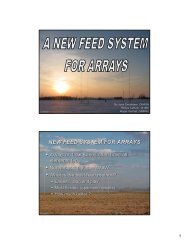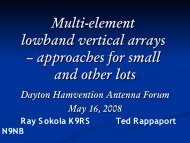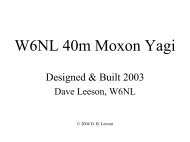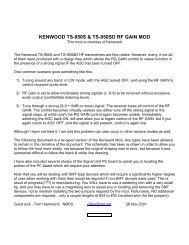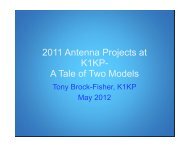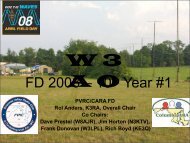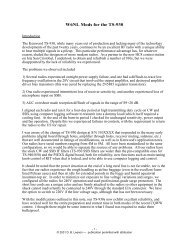Create successful ePaper yourself
Turn your PDF publications into a flip-book with our unique Google optimized e-Paper software.
<strong>ELECRAFT</strong> <strong>K3</strong> <strong>QUICK</strong>-<strong>START</strong> <strong>GUIDE</strong><br />
To get started using your <strong>K3</strong> right away, please read this short tutorial section and try each of the controls. The text<br />
uses braces to refer to numbered elements in Figures 1 and 2. For example, {1} refers to 1 , the mic jack .<br />
Later sections provide greater detail on all aspects of <strong>K3</strong> operation. For a description of LCD elements, see pg. .<br />
8 9 10 11 12 13<br />
14<br />
7<br />
BAND<br />
MENU<br />
DISP<br />
E L E C R A F T K 3<br />
T R A N S C E I V E R<br />
A / B REV A B<br />
1<br />
2 3<br />
V<br />
M<br />
M<br />
V<br />
6<br />
5<br />
VOX<br />
ALT<br />
MODE<br />
POWER<br />
QSK<br />
TEST<br />
CONFIG<br />
XMIT<br />
TUNE<br />
RX<br />
ANT<br />
METER<br />
ATU<br />
TUNE<br />
ATU<br />
ANT<br />
S1 3 5 7 9 +20 40<br />
SWR<br />
2 3<br />
RF<br />
50 100<br />
II<br />
60<br />
AGC-S<br />
ANT 2<br />
PRE<br />
XFIL<br />
FL2<br />
ATU<br />
SUB<br />
USB<br />
A<br />
TX<br />
B<br />
B SET<br />
PRE<br />
4<br />
ATT<br />
NB<br />
7<br />
VFO<br />
AGC<br />
5<br />
OFF<br />
NR<br />
8<br />
SPLIT<br />
XFIL<br />
6<br />
DUAL PB<br />
NTCH<br />
9<br />
AF REC AF PLAY<br />
M1 M2<br />
REC<br />
M3 M4<br />
15<br />
4<br />
3<br />
2<br />
1<br />
TX<br />
PHONES<br />
∆f<br />
MIC RF / SQL SUB<br />
AF SUB SHIFT LO CUT HI WIDTH<br />
- +<br />
SPEED<br />
MIC<br />
NORM<br />
DELAY<br />
- +<br />
CMP<br />
PWR<br />
- + - +<br />
I / II<br />
MON<br />
A<br />
FREQ<br />
ENT<br />
SCAN<br />
FINE<br />
COARSE<br />
RATE<br />
LOCK<br />
SUB<br />
LEVEL<br />
SPOT<br />
.<br />
PITCH<br />
B<br />
ADJ<br />
CWT<br />
0<br />
TEXT DEC<br />
MAN<br />
AFX<br />
DATA MD<br />
MESSAGE<br />
RIT XIT<br />
PF1 PF2<br />
CLR<br />
-<br />
+<br />
16<br />
17<br />
25 24 23 22 21 20 19 18<br />
Figure 1. Front Panel<br />
30<br />
31<br />
32<br />
ANT 1<br />
RS232<br />
ACC<br />
29<br />
28<br />
ANT 2<br />
SPKRS PHONES MIC IN LINE<br />
!<br />
STEREO<br />
+ +<br />
MONO<br />
MONO<br />
OUT<br />
STEREO<br />
!<br />
33<br />
RX ANT<br />
XVTR<br />
IF OUT<br />
27<br />
AUX RF<br />
IN OUT IN OUT<br />
34<br />
26<br />
12VDC IN<br />
12VDC OUT<br />
0.5 A MAX.<br />
SWITCHED<br />
GROUND<br />
SERIAL NO. 05000<br />
PADDLE<br />
KEY<br />
PTT IN<br />
KEY OUT<br />
REF. IN<br />
38<br />
37<br />
36 35<br />
Figure 2. Rear Panel
Connections • Connect a power supply to the DC input jack {26} (see Specifications, pg. ).<br />
• On the <strong>K3</strong>/100, a circuit breaker is provided on the fan panel for the 100-W stage {30}.<br />
Low-power circuitry is protected by an internal self-resetting fuse.<br />
• You can power an accessory device from the switched DC output jack {38} (0.5 A max).<br />
• Connect an antenna to ANT1 {29}. If you have an ATU installed (pg. ), you can connect<br />
a second antenna to ANT2 {28}. AUX RF {27} is for use with the subreceiver (pg. ).<br />
• See page for a full description of the <strong>K3</strong>’s rear-panel connectors.<br />
The Basics<br />
POWER<br />
Filter<br />
Controls<br />
Voice Modes<br />
{1}<br />
CW Mode<br />
{36}<br />
• Press POWE R {5} to turn on the <strong>K3</strong>. If there are any error indications, refer to page .<br />
• TAP and HOL D Functions: Tapping briefly activates the function labeled on a switch.<br />
Holding for about 1/2 second activates the function labeled beneath a switch.<br />
• Tap either end of BAND {7} to select a band, and MODE {6} to select the mode. Set the<br />
AF gain using AF {2}. Set RF to max. Set SUB AF to min (pg. ).<br />
• The large knob {22} controls VFO A (upper display, {10}). The medium knob {19}<br />
controls VFO B (lower display, {11}). VFO A is main RX/TX except in SPLIT (pg. ).<br />
• CMP / PWR is one of four multifunction controls {24}. Each has two primary<br />
functions, indicated by the green LEDs above them. Tap the knob to select the desired<br />
function, in this case CMP (speech compression level) or PWR (power output in watts).<br />
Hold the knob to activate its secondary function, in this case MONitor level.<br />
• Rotate the SHIFT / LOCUT and HICUT / WIDTH controls {23} to adjust the filter<br />
passband. Crystal filters FL1-FL5 are automatically selected as you change the<br />
bandwidth. Tap either knob briefly to alternate between shift/width and hicut/locut.<br />
• Hold SHIFT / LOCUT to NOR Malize the bandwidth (e.g., 400 Hz CW, 2.8 kHz SSB).<br />
• Hold HICUT / WIDTH to alternate between two filter setups, I and II (per-mode).<br />
• Tap XFIL {13} to select crystal filters manually; this also removes any passband shift.<br />
• Hold MET ER {8} to select CMP / ALC metering. Set MIC {25} for 4-7 bars of ALC,<br />
and CMP for the desired compression. Then return to SWR / PWR. (Pg. .)<br />
• Optional: Hold TES T {6} for TX TEST; allows off-air adjustment (TX icon flashes).<br />
• Hold CMP / PWR {24} to set speech MONitor level; tap to return to CMP / PWR.<br />
• Hold VOX {7} to select PTT or VOX. Hold SPEED / MIC to set VOX DELAY.<br />
• Additional details: VOX (pg. ), TX EQ (pg. ), MIC (pg. ), AM & FM (pg. ).<br />
• SPEED {25} sets the CW keyer speed. Hold this knob to set semi-break-in DELAY.<br />
Hold QSK {7} to select full break-in (QSK icon on) or semi-break-in. (Pg. .)<br />
• Hold PIT CH {18} to set sidetone pitch. Hold CMP / PWR to set sidetone MON level.<br />
• Tap CWT {18} to enable tuning aid {9}. With CWT on, SPOT auto-tunes CW signals.<br />
• To select CW text decode/display mode, hold TEX T DE C {18}, then rotate VFO B.<br />
• CW keying is converted to DATA in FSK D and PSK D modes (below and pg. ).<br />
• Hold DUA L PB {13} to turn CW dual-passband receive mode on or off (pg. ).<br />
Data Modes<br />
CQ {31} data input or keyer), or PSK D (PSK via data input or keyer). VFO A selects baud rate<br />
for internal text decoder, if applicable. Additional details on DATA modes: pg. .<br />
• Hold DAT A MD {18}. Use VFO B to select from: DATA A (PS<strong>K3</strong>1 & miscellaneous<br />
soundcard-based modes), AFSK A (soundcard-based RTTY), FSK D (RTTY via<br />
• Hold PIT CH {18} to select mark tone and shift (for decoder and dual-tone filter).<br />
• Hold TEX T DE C {18} to turn on RTTY or PS<strong>K3</strong>1 text decode. Tap CWT for tuning aid.
VFOs<br />
and<br />
RIT/XIT<br />
• RATE {21} selects 10 or 50 Hz VFO/RIT tuning (pg. ). Also see VFO menu entries.<br />
• FINE {21} selects 1-Hz steps. COA RSE selects large tuning steps (per-mode; pg. ).<br />
• Tap FREQ ENT {21} to enter frequency in MHz using numeric keypad. Tap return ( )<br />
to complete the entry, or tap FREQ ENT again to cancel. (Pg. .)<br />
• Hold SCA N to start/stop scanning. SCAN must be preceded by a memory recall (pg. ).<br />
• The RIT and XIT offset knob {17} has LEDs that show -/0/+ offset (pg. ). Tap CLR<br />
{16} to zero the offset. Hold CLR for > 2 sec. to add the offset to VFO A, then zero it.<br />
XMIT<br />
and ANT<br />
Controls<br />
NB, NR,<br />
and Notch<br />
()<br />
SPLIT,<br />
BSET,<br />
and SUB<br />
Memories,<br />
Messages,<br />
and DVR ()<br />
• The TX LED {4} indicates that the <strong>K3</strong> is in transmit mode. The ∆f LED turns on if the<br />
RX and TX frequencies are unequal (SPLIT, RIT/XIT, cross-mode, etc.). (Pg. .)<br />
• XMIT {8} is equivalent to PTT {35}. Hold TUN E to put out full CW power.<br />
• Tap ATU TUNE {8} to auto-tune (KAT3). Hold ATU to select normal/bypass ATU mode.<br />
• ANT to selects ANT1 or ANT2 (KAT3). RX A NT selects main or RX antenna (KXV3).<br />
• Tap NB {12} to turn on DSP and/or I.F. noise blanking. Hold LEV EL to set NB levels<br />
using VFO A (DSP) and VFO B (I.F.). Fully CCW is OFF in both cases. (Pg. .)<br />
• Tap NR {12} to turn on noise reduction. Hold ADJ to tailor noise reduction for the<br />
present band conditions (pg. ).<br />
• Tap NTCH {12} once to select auto-notch (NTC H icon), and a second time to select<br />
manual notch (adds < > icon). Hold MAN to adjust manual notch frequency. (Pg. .)<br />
• Hold SPL IT {13} to enter split mode (RX on VFO A, TX on VFO B). If VFOs A and B<br />
are on different frequencies in SPLIT mode, the Delta-F LED () will turn on (pg. ).<br />
• Tap BSET {13} to adjust VFO B settings independent of VFO A (pg. ).<br />
• Tap SUB {20} to turn on the subreceiver (pg. ). VFO B controls its frequency.<br />
• The subreceiver can use its auxiliary input or share antennas with the main receiver. Which<br />
antennas are available to main and subreceivers depends on installed options (pg. ).<br />
• To store a frequency memory, tap V > M {14}, then: tap M1 -M4 {15} to save a per-band<br />
quick memory; or tap 0 -9 to save a general-purpose quick memory; or rotate VFO A to<br />
select from memories 0-99, then tap V > M again to save. Tap M > V to recall. (Pg. .)<br />
• M1 -M4 and REC {15} are also used to record and play CW or voice messages. The<br />
KDVR3 option is required for voice messages and audio record/playback (pg. ).<br />
Menus () • MENU & CON FIG {8} access the MAIN and CON FIG menus. VFO B selects entries;<br />
VFO A changes parameters. CON FIG menu entries are used less often.<br />
• Tapping DISP {8} within menus shows information about each entry on VFO B (pg ).<br />
• Up to 10 menu entries can be assigned to programmable function switches. PF1 and PF2<br />
{16} are dedicated to programmable functions. Any of M1 -M4 {15} can be used as Tap<br />
and/or Hold programmable functions if they’re not being used for message play (pg ).<br />
Other<br />
Features<br />
• RX and TX EQ (MAIN menu) provide 8 bands of receive/transmit equalization (pg. ).<br />
• Tap AFX {18} to enable binaural audio effects (AFX MD menu entry. pg. ).<br />
• Tap DISP {8} and use VFO B to show time, supply voltage, etc. on VFO B (pg. ).<br />
• The ALA RM function (MAIN menu) can be used to remind you about a contest, <strong>net</strong>, or<br />
QSO schedule. The <strong>K3</strong> will be turned on automatically if it is off at the time of alarm.




